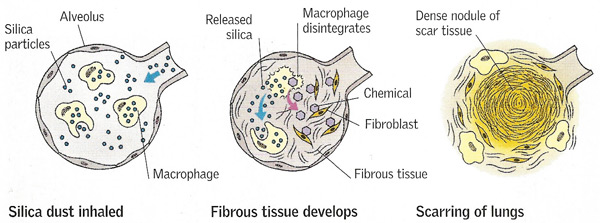pneumoconiosis

Pneumoconiosis is an occupational disease in which scarring of the alveoli (air sacs) in the lungs occurs due to irritation by dust particles. One form of the disorder, silicosis (shown here), is caused by inhalation of silica dust. From right to left: Silica dust is inhaled. Inhaled silica dust is deposited in the alveoli and ingested by scavenging white blood cells and macrophages. Fibrous tissue develops. The macrophages die, releasing the silica and chemicals that attract fibroblasts, cells that produce fibrous tissue. Scarring of lungs. The process is repeated and more fibrous tissues develops, leading to the formation of dense nodules of scar tissue.
Pneumoconiosis is a restrictive disease of the lungs caused by deposition of various kinds of dust in the lungs, inhaled during years of exposure, often in extractive industries. Silicosis, anthracosis, and asbestosis are the principal forms, although aluminum, iron, tin, and cotton fiber also cause pneumoconiosis. Characteristic X-ray changes are seen in the lungs.
Symptoms and complications
The main symptom of pneumconiosis is shortness of breath. In severe cases, cor pulmanole (right-sided heart failure due to lung damage) or emphysema (destruction of the alveoli) may develop. The risk of tuberculosis is increased in coal workers' pneumoconiosis and silicosis; the risk of lung cancer is increased in asbestosis. Smoking further increases the risk.
Diagnosis and treatment
Pneumoconiosis is often detected by a chest X-ray before symptoms develop. Diagnosis is also based on a history of exposure to dusts, medical examination, and on pulmonary function tests. There is no treatment for the condition apart from treating any complications. Further exposure to dust must be avoided.


